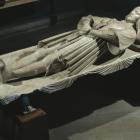Agostino Busti known as il Bambaia, Statue of a reclined Gaston de Foix, Carrara marble, 1517-1522 (inv. n. 1433)
The reclined figure, the Gisant, is part of a sepulchre commissioned by Francesco I, King of France, in honour of Gaston de Foix, who died in the battle of Ravenna in 1512, while still in his early 20s. The monument was destined for the Milanese church of Santa Marta, a church favoured by the filo-French aristocracy, in what today is piazza Mentana. A document dating to 1517 refers to the “superb sarcophagus”, but just a few years later the work was interrupted due to end of French domination. In the 17th century and again during the 19th century many of the sepulchral elements were dispersed and subsequently acquired by private and public collectors (Milan, Pinacoteca Ambrosiana; Turin, Palazzo Madama; London, Victoria and Albert Museum). Following the acquisition of the marbles formerly belonging to the Arconati family, from 1990 the Sforza Castle has been in possession of the most notable nucleus of the monument, including the series of apostles, the allegorical figures and the narrative reliefs, which splendidly portray the military leader's acts of valour (room IX, XV). The reclined statue of Gaston de Foix is recognised as the master work of Agostino Busti, the most authoritative exponent of the Lombard renaissance. The virtuosity of the marble surface carvings is confined to the decorative areas, while the craftsmanship of the sculptor emerges from the serene and classic composure which finds its expression in the face of the French hero.








